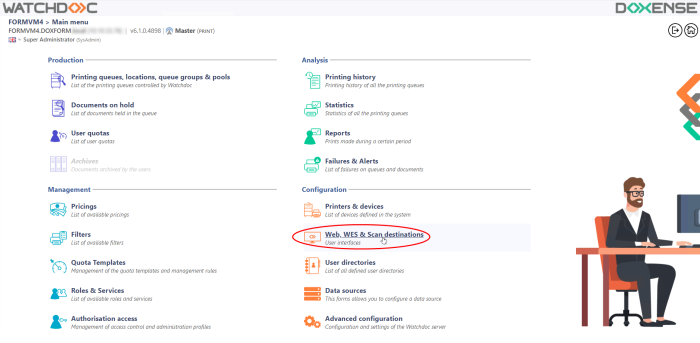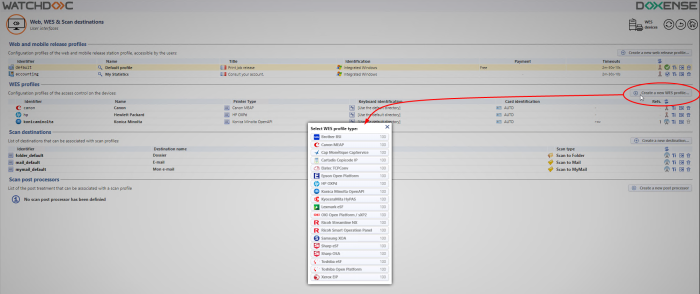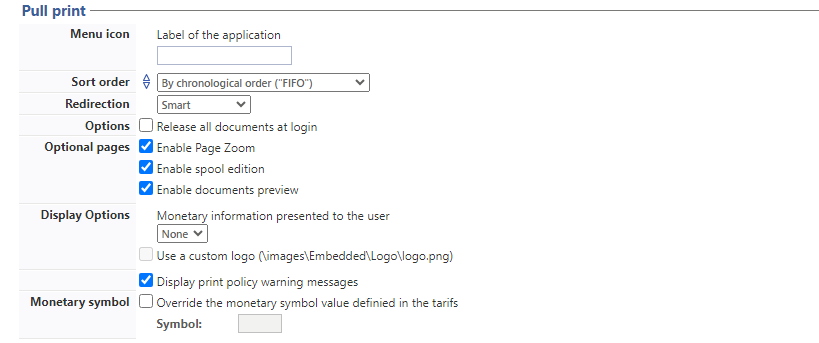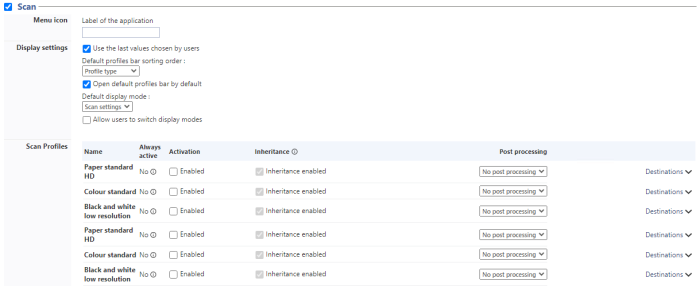Konica Minolta WES - Create and configure the WES profile
Create the WES profile
On a clean Watchdoc installation, a first WES profile is automatically created with default parameters at the end of the wizard procedure, but you can, at any time, edit existing profiles to modify them or create a new profile.
-
From the Main menu in the administration interface;
-
in the Configuration section, click on Web, WES & Scan destinations:

-
in the Web, WES & Scan Destinations - Client Interface Management interface, click on Create a new WES profile;
-
in the list, select the profile you want to create:

è you will access the Create a WES profile form, which contains a number of sections in which you can configure your WES.
A navigation bar helps you quickly access the desired section:
Configure the WES profile
Configure the Properties section
Use this section to state the main WES properties:
-
Identifier: Enter the single identifier for the WES profile. It can comprise letters, numbers and the '_' character with a maximum of 64 characters. This identifier is only displayed in the administration interfaces.
-
Name: enter the WES profile name. This explicit name is only displayed in the administration interfaces.
-
Global : in the case of a master/slave configuration, tick this box to replicate this profile on the slave servers.
-
Language: Select the WES display language configured from the list. If you select Automatic detection, the WES adopts the language it finds by default in the device configuration.
-
Version: select the version of WES. For v3, you can customise the interface by choosing the colour of the buttons and images to match your graphic identity:
-
Colour: enter the Hexadecimal color value corresponding to the WES button's colour. By default, the buttons are Watchdoc® orange customized (#FF901). Once the value is entered, the colour is displayed in the field.
-
Images: if you want to customize the WES images, enter the folder path in which are recorded images you want to display instead of the default images (stored in C:\Program Files\Doxense\Watchdoc\Images\Embedded\Doxense\[Manufacturer_Name] by default).
-
For more information on the customization, see the section Customizing the WES buttons and image.
Configure the keyboard authentication
-
Keyboard authentication: tick the box to allow user authentication from a physical keyboard or touch screen, and then specify how this authentication is to be carried out:
-
Authentification mode: from the list, select the authentication mode you wish to activate:
-
PUK code: the PUK code is automatically generated by Watchdoc according to the parameters defined in the directory. This code is communicated to the user on the "My account" page;
-
Login and PIN code authentication: composed of 4 or 5 digits, the user's PIN code (1234, for example) is stored as an LDAP attribute or in a CVS file;
-
login and password authentication: authorise authentication by username and password.
-
-
Directory: from the list, select the directory to be queried during keyboard authentication, depending on where the users are registered.
-
Keyboard: from the list, select the type of keyboard to offer users for authentication:
-
Virtual: when the user clicks on the Pin Code button, the virtual keyboard is displayed so that they can enter their code. This type of keyboard is less user-friendly than the physical keyboard, but should be used if the PIN code can begin with '0';
With Konica-Minolta devices, use of the virtual keyboard in PUK code mode is almost compulsory, for two reasons:
-
the physical keyboards on devices only allow 9 digits to be entered, whereas the default PUK code algorithm has 10 digits;
-
devices' physical keyboards systematically delete the first character of the PUK code if it is a 0, which can lead to authentication errors.
-
-
Physical: the user clicks on the Pin Code button and types the code directly into the copier's numeric keypad. This type of keypad requires fewer steps, but cannot be used if the PIN code can begin with '0'.

-
Configure the card authentication section
Card authentication: tick the box (at the section level) to enable user authentication from a card, then set out how this authentication works:
-
Directory: From the list, select the directory to query during cards authentication. If no directory is set, Watchdoc will query the default directory.
-
Self registration: If you enable the self-registration
 Action when a user account is assigned to a badge number belonging to
them. Enrolment takes place when a badge is used for the first time. Enrolment may be performed by the IT services manager when they issue a badge to a user or by the user themselves by entering their ID (PIN, PUK or ID and password) which is then assigned to their badge number. Once enrolment is complete, the badge number is definitively assigned to their owner. (or enrolment) from the WES, state how the user assigns their card to their account:
Action when a user account is assigned to a badge number belonging to
them. Enrolment takes place when a badge is used for the first time. Enrolment may be performed by the IT services manager when they issue a badge to a user or by the user themselves by entering their ID (PIN, PUK or ID and password) which is then assigned to their badge number. Once enrolment is complete, the badge number is definitively assigned to their owner. (or enrolment) from the WES, state how the user assigns their card to their account:
PUK code: the user enters their PUK code to enrol their badge;
User name and PIN code: the user enters their name and PIN code to enrol their badge;
Login and password: the user enters their LDAP account (login and password) to enrol their badge;
Notify the user: tick the box to notify the user once their badge has been enrolled;
Format: if necessary, indicate how the character string of the badge number read is to be transformed. Ex: raw;cut(0,8);swap.
Configure the Anonymous connection
Check this section to enable anonymous login to allow a non-authenticated user to access the device by clicking on a specific button.
You can restrict the functionality that the anonymous user can access by applying a rights policy to the queue, group or server and using the Anonymous User filter.
-
Button label: in this field, enter the label displayed on the device functions access button. The default text is Anonymous :

Configure the Accounting section
In this section, specify whether you want accounting to be performed by the device itself or from the Windows spooler.
When this function is activated, log management must also be activated when installing the WES on the queue (see Installing the WES on the queue).
-
Device: Uses the prints accounting: tick this box if you want accounting to be handled by the device. In this case, specify the accounting mode:
-
Source: select the source of the accounting data from the list:
-
Job log: this mode allows the job count to be read when a user logs on more than 15 minutes after the previous reading;
-
Events: this mode allows jobs to be logged as soon as a user authenticates. Anonymous jobs are therefore not counted. This Event mode works if the user's account (login and password) is registered in the printer driver on the user's workstation.

-
Configure the Pull-print section
In this section, you specify the parameters relating to the print-on-demand function, i.e. the interface from which users access their pending jobs and from which they delete or validate prints :
-
Menu icon: to access the print-on-demand interface, the user clicks on the Watchdoc logo. By default, this logo is entitled My print jobs.
-
Application name: enter the wording you wish to associate with the logo instead of the default wording ;
-
-
Sort Order: in the list, select the order in which the printouts should be presented on the WES :
-
by reverse chronological: from most recent to oldest;
-
Chronological: from oldest to most recent.
-
-
Redirection: specify the behaviour of the WES when the user logs on, and in particular the redirection to a page other than the home page:
-
No redirection: the WES displays the default home interface and does not redirect to any other interface;
-
Smart: the WES displays the default home interface if the user has no pending documents; on the other hand, if the user has pending documents, the WES displays the list of documents;
-
Waiting jobs: the WES displays the list of pending documents even if there are none.
-
Options:
-
Release all documents at login: tick the box to ensure that all queued jobs are automatically printed when the user logs on to the print device. In this case, the user does not access the list of queued jobs to validate which ones to print.
-
-
Optionnal pages:
-
Enable Zoom Page:tick this box to enable the user to zoom in on jobs waiting to be printed;
-
Enable spool edition: tick this box to activate the spool transformation function;
-
Enable previews on job page : tick this box so that the user can preview pending jobs before confirming printing
-
-
Display Options: In the list, select the monetary information presented to the user via the WES: none, the price or the cost of their prints.
-
Use a custom logo: (for WES V2 only) tick the box if you want to display a custom logo instead of the default Watchdoc logo.
-
Display print policy warning messages: tick this box if you wish to inform users of the printing policy in place which could change their initial choices.
-
Symbol: if you wish, enter a currency symbol other than the default € symbol.

-
Configure the analytical codes section
In this section, you indicate whether you wish to activate the function that allows users to charge their jobs to predefined accounts to facilitate cost accounting for print jobs
-
Enable option: tick the box to activate the Analytical Codes function;
-
Data source: in the list, select the source corresponding to the analytical if there is more than one. By default, the data source is named DS_BILLINGCODES.
-
Deny access if the user does not have the analytical code selected: tick the box to force the user the user to specify an imputation code.
-
Search scope: if the user does not know the code to be allocated, he can carry out a search in the "Code" field, in the "Description" (label corresponding to the code) or on both fields simultaneously. From the list, select the field or fields available to the user to search for the account.
-
Search mode: specify whether the search is for the beginning of the value or a part of the value.

Configure the Quota section
- Enable option: tick the box to enable the WES to manage print quotas

Configure the Scan section
This section is used to configure the WEScan function (see WEScan).
-
Icon in the menu: to access the interface, the user clicks on the WEScan logo. By default, this logo is called WEScan.
-
Menu icon: enter the wording you wish to associate with the logo instead of the default wording ;
-
-
Display settings
-
use last selected values... Check the box to suggest the most frequently used scanning profiles (predefined settings), which saves time when scanning is used in the same way. Then specify whether classification should be done using ;
-
profile type: most frequently selected profile;
-
date of use: profile chosen the last time it was used.
-
-
Open default profiles bar : tick this box to offer an interface in which the user can choose between all the scan settings, which is useful when scanning is used for a wide variety of purposes. Then specify whether you want to display the scan settings: the user is free to choose the settings; profiles: the user chooses from predefined scan profiles.
-
profiles type: the user chooses from predefined scan profiles.
-
Last date of use: the user chooses from predefined scan profiles.
-
-
-
Allow users to switch display modes: tick this box to allow users to customise their interface by choosing their preferred display mode.
-
Scan profiles: for each profile listed, you can check:
-
activation: to make it active in the embedded interface;
-
inheritance: to allow the user to create a new profile inheriting the parameters of the existing profile. The user will then be free to modify one or more parameters of the original profile;
-
Post processing: if a post-scan treatment has been configured (see Post-scan processor), select it from the list ;
-
destinations: the destination is the place where the scanned document is sent. For each profile, you can activate, deactivate and define one or more destinations by default:
-
E-mail: Send the scan to the e-mail of a recipient entered in the interface;
-
My e-mail: Send the scan to the user's email (always known if the user has an AD account);
-
Folder: Send the scan to a predefined folder in the workspace accessible to the user.

-
-
Configure the Device section
This section is used to define the connection mode between the server and the print devices.
-
Fault tolerance: tick this box to enable fault tolerance based on load-balancing. If you enable this function, you will need to configure interserver printing (see Configuring interserver printing).
-
Network: you can override the network settings if the device is not configured by default
-
Server Address type: The device needs to contact the Watchdoc server when the user tries to connect or wants to release his documents. You can specify the Watchdoc server address in three different ways:
-
IP Address,
-
DNS Address;
-
DNS Alias;
-
Custom Address;
-
-
Use SSL to display Web Pages on the device: thick this box if you want that Watchdoc uses this protocol to communicate with the device. Since Watchdoc v. 6.1.0.5262, you can specify whether you wish to use:
-
the custom access point (previously configured in the DSP section (see Configuring the Web Server):
-
the Watchdoc server's default port 5753 ;ConfigServeurWeb_EN.htm
-
-
Credentials: enter the administrator login and password required to configure OpenAPI in the field.
-
Use a secured connection when interacting with the device for SOAP calls: thick this box if you want that
-
Credentials: enter the administrator login and password required to configure OpenAPI in the field.
Customisation of the home panel icons:
-
Enable: tick the box to display only the Print on Demand, Copy and WEScan buttons on the print device menu (if these functions are enabled on the print devices) ;
-
Use SSL: tick the box to use this protocol when connecting Watchdoc to the device administration website to modify the menu icons;
-
Port of the device's web site: enter the port 50003 used to access the device administration website in this field:

-
-
Configure the Misc. section
-
Messages: In this field, enter two help messages displayed on the device's screen to assist users in using the interface and asking for help if they need it:

History section
This section displays information on the configured WES and on modifications made to it :
Validate the profile
1. Click the button  to validate the WES profile configuration.
to validate the WES profile configuration.
→ Once validated, the WES profile can be applied to a print queue.
